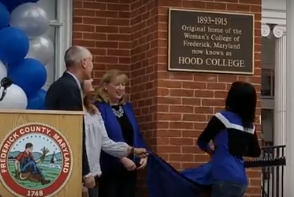“From the Archives” appears in every issue of The Blue and Grey. On the top is an article from the back issues of The Blue and Grey, and on the bottom is a present day analysis from one of our staff reporters. This column highlights the historical value of our publication and links the past to the present
Increased Enrollment Brings Problem of Lack of Space
By Ruth Kaiser ‘64
The Blue and Grey, April 27, 1962
With the enrollment at Hood about to be increased to seven hundred fifty, there will undoubtedly be space problems. Several suggestions have already been offered to alleviate the situation.
Triple Bunk Beds
Many of the extra students will probably begin attending Hood before the new dormitory is completed, which means that some double rooms will have to house three girls. Thus the Mothers’ Club should be asked to buy one triple bunk bed for each triple room to save space.
To further facilitate matters, each girl should get up five minutes later than the girl beneath her to avoid injury and confusion while climbing out of the bunks in the morning. Breakfast would be served at 7:25, 7:30, and 7:35 a.m. Classes would begin at the usual 8 a.m., with the last shift from the top bunk arriving at 8:10—just in time to avoid a cut.
Crowded Dining Hall
Space in the dining hall will be at a premium also. The freshman and sophomore classes will be the largest. Therefore, seniors should be asked to use the side doors.
Nine people would be seated at each table, with positions rotating so that no one will always have the table leg in her lap. Dice would be rolled (or straws drawn) on days that hamburgers are served to determine which students will go hungry.
Post Office Problems
Major space problems will be created in the already overcrowded post office. The best suggestion seems to be to knock out the south wall and expand the post office into the hall.
Students would enter in an orderly manner through the bookstore turnstiles, with armed campus police present during rush hours to prevent any overly anxious students from going through the turnstiles backwards.
From the Present
In fall of 2011 there were 1,487 undergraduate students enrolled at Hood, nearly twice the amount that seemed so large back in 1962. Ruth Kaiser shared her ideas about what changes could be made to help students adjust to a larger population, but 50 years later Hood has managed to avoid these extreme modifications.
While there are some triples and quads on campus, Hood has yet to resort to triple bunk beds. With the exception of the first floor of Shriner, such a bed would result in students having to squirm their way into their respective level, and an epidemic of claustrophobia would sweep amongst students.
Since the earliest class at Hood is now at 8:30, and most students avoid that timeslot with all their might; staggering schedules would no longer be necessary. However, the arrangement of alarm clocks would be crucial to keeping the peace in the room; if one roommate sleeps through their alarm or disturbs the other occupants, payback would be easily within reach.
The dining hall crowd that Kaiser envisioned probably looked much like the 12:35 rush that occurs at lunch time, when a line of students often snakes down the steps of Coblentz. Snagging a table can be difficult during this time; students often end up in the furthest depths of the dining hall at the last open table.
I have been at a table so crowded that there is barely enough room in front of you for your plate, but this is more often than not by choice, not by necessity. The seats awkwardly by the table leg are still a problem; I have banged my knee on an embarrassingly large number of occasions.
The post office of 1962 sounds much different than what we have today, which is not surprising considering that Whitaker was built in the 90s. I am not entirely sure where the post office was located, but can you imagine campus security guarding students who were desperately waiting to get their mail?
Since Kaiser made her suggestions, Hood’s population has continued to grow. Could these methods help to create more space on campus? If you have any ideas or stories about the dorms, send us an email!




Be the first to comment